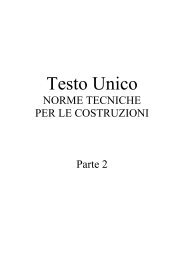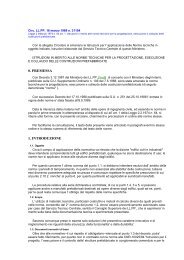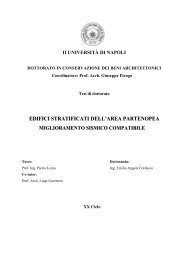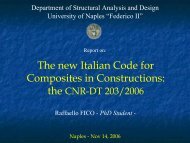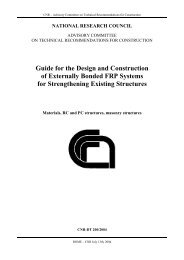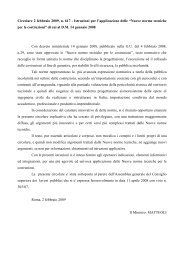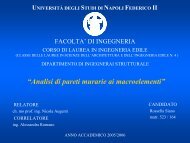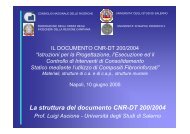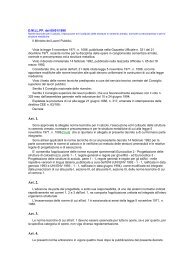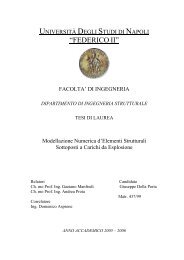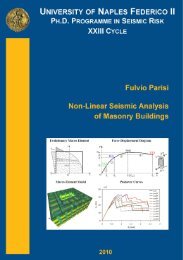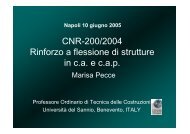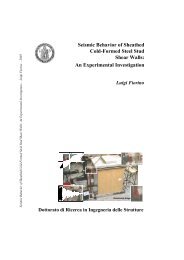Esempi di rinforzo a FLESSIONE con FRP - Università degli Studi di ...
Esempi di rinforzo a FLESSIONE con FRP - Università degli Studi di ...
Esempi di rinforzo a FLESSIONE con FRP - Università degli Studi di ...
You also want an ePaper? Increase the reach of your titles
YUMPU automatically turns print PDFs into web optimized ePapers that Google loves.
<strong>Esempi</strong> numerici – F.Ceroni – A.ProtaSeminario <strong>di</strong> Stu<strong>di</strong>o sul documentoCNR-DT200/2004Napoli, 10 Giugno 2005<strong>Esempi</strong> <strong>di</strong> <strong>rinforzo</strong> a <strong>FLESSIONE</strong><strong>con</strong> <strong>FRP</strong> – Stato limite ultimoIng. Francesca Ceroniceroni@unisannio.itUniversità <strong>degli</strong> Stu<strong>di</strong> del SannioSeminario <strong>di</strong> Stu<strong>di</strong>o sul documento CNR-DT200/2004 – 10 Giugno 2005
<strong>Esempi</strong> numerici – F.Ceroni – A.Prota<strong>Esempi</strong>o 1Seminario <strong>di</strong> Stu<strong>di</strong>o sul documento CNR-DT200/2004 – 10 Giugno 2005
<strong>Esempi</strong> numerici – F.Ceroni – A.Prota1) Sezione in c.a. – Calcolo del momento ultimo• base trave b = 30 cm;• altezza utile d =46 cm;• copriferro 4 cm;• calcestruzzo Rck 250;• Area <strong>di</strong> acciaio intrazione 7.63 cm 2(Feb44k)calcestruzzo: f cd=0.85⋅0.83⋅Rck/1.6 = 110 kg/ cm 2 ;Resistenze materialiacciaio: f yd=4400/1.15 = 3826 kg/cm 2 ; Es=210000 MPaAdottando la semplificazione dello stress block le equazioni <strong>di</strong> equilibrio si scrivono:0.8⋅ b ⋅ y ⋅ f − A1⋅ f =ccdsyd00.8⋅ 30 ⋅ yc⋅110− 7.63 ⋅ 3826 =0y c = 11cmMu= 0.8⋅ b ⋅ yc⋅ fcd⋅ ( d − 0.4 ⋅ yc)M uSeminario <strong>di</strong> Stu<strong>di</strong>o sul documento CNR-DT200/2004 – 10 Giugno 2005= 0.8⋅30⋅11⋅110⋅(46− 0.4 ⋅11)La <strong>di</strong>fferenza <strong>con</strong> il metodo esatto è trascurabileLa rottura avviene in maniera bilanciata acciaio-clsM u= 12.1tm
<strong>Esempi</strong> numerici – F.Ceroni – A.Prota2) Sezione in c.a. rinforzata <strong>con</strong> C<strong>FRP</strong> applicato su struttura già caricatay 0• Momento dovuto ai carichipresenti all’atto dell’appplicazionedel <strong>rinforzo</strong>:M0 = 4.5tm• Momento ultimo della sezionenon rinforzata:M u= 12.1tm• Momento richiesto:M sD= 14 tm• Calcolo dello stato tensionale inizialeyoCalcolo posizione asse neutro: Sn = byo+ nAs2(yo− d2) − nAs1(d− yo) = 0 y o=15.2cm2Calcolo Inerzia:I13322co = by o + nA s2 (y o − d2) + nA s1(d− y o )I co=141933 cm 4Deformazione clscompresso:Moyoεco = = 0.000162 Deformazione h − yoεo = εco= 0. 00328EcIcolembo teso:yoSeminario <strong>di</strong> Stu<strong>di</strong>o sul documento CNR-DT200/2004 – 10 Giugno 2005
<strong>Esempi</strong> numerici – F.Ceroni – A.Prota3) Sezione in c.a. rinforzata <strong>con</strong> C<strong>FRP</strong> applicato su struttura già caricataHdδAs1tfyc=ξbHεco12 3εs,elεc=0.35%σcσs1σfMCalcolo dellamassima tensionenella laminaε o= 0.00328bAfεfu,dεo- spessore <strong>FRP</strong>: 0.0164cm; larghezza <strong>FRP</strong>: 30cm;- tensione caratteristica <strong>di</strong> rottura: f f,uk = 4900 MPa- modulo elastico: E f = 240000MPa, ε f,uk = 0.0204Con<strong>di</strong>zione <strong>di</strong> esposizioneEsposizione internaEsposizione esterna(ponti, colonne e parcheggi)Ambiente aggressivo (centralichimiche e centrali <strong>di</strong> trattamentodelle acque) Arami<strong>di</strong>ca /Epossi<strong>di</strong>ca 0.70Seminario <strong>di</strong> Stu<strong>di</strong>o sul documento CNR-DT200/2004 – 10 Giugno 2005⎛ ε ⎞fuε = min ,fd η εa f ,max⎜γ ⎟⎝ f ⎠Fattore <strong>di</strong> <strong>con</strong>versioneTipo <strong>di</strong> fibra / resinaambientale, η aCarbonio / Epossi<strong>di</strong>ca 0.95Vetro / Epossi<strong>di</strong>ca 0.75Coefficiente Applicazione ApplicazioneArami<strong>di</strong>ca / Epossi<strong>di</strong>ca Modalità <strong>di</strong> collasso 0.85parzialetipo A (1)tipo B (2)Carbonio / Epossi<strong>di</strong>ca Rottura 0.85γ f 1.10 1.25Vetro / Epossi<strong>di</strong>ca Delaminazione 0.65γ f,d 1.20 1.50Arami<strong>di</strong>ca / (1) Epossi<strong>di</strong>ca Applicazione <strong>di</strong> sistemi 0.75 <strong>di</strong> <strong>rinforzo</strong> prefabbricati in <strong>con</strong><strong>di</strong>zione <strong>di</strong> <strong>con</strong>trollo <strong>di</strong> qualità or<strong>di</strong>nario;Carbonio / applicazione Epossi<strong>di</strong>ca <strong>di</strong> tessuti a 0.85 mano in cui siano stati presi tutti i necessari accorgimenti per <strong>con</strong>seguire unVetro / Epossi<strong>di</strong>ca elevato <strong>con</strong>trollo <strong>di</strong> qualità 0.50 sulle <strong>con</strong><strong>di</strong>zioni e sul processo <strong>di</strong> applicazione.(2) Applicazione <strong>di</strong> tessuti a mano in <strong>con</strong><strong>di</strong>zione <strong>di</strong> <strong>con</strong>trollo <strong>di</strong> qualità or<strong>di</strong>nario; applicazione <strong>di</strong> qualsiasisistema <strong>di</strong> <strong>rinforzo</strong> in <strong>con</strong><strong>di</strong>zioni <strong>di</strong> <strong>di</strong>fficoltà ambientale o operativa.ε fd= min (0.0155, ε f,max)
<strong>Esempi</strong> numerici – F.Ceroni – A.Prota6) Verifica dell’ancoraggio per <strong>rinforzo</strong> <strong>con</strong> 1 strato <strong>di</strong> C<strong>FRP</strong>• Calcolo della lunghezza <strong>di</strong> trasferimentoLt,maxf f ctm 2= E t /(f ⋅ c )=240000 ⋅0.164/(2.3⋅ 2) =92mm2 − bf/ b 2 − 300/300• Coefficiente <strong>di</strong> forma kb=== 0.76 < 11+b / b 1+300/ 400fo• Tensione <strong>di</strong> delaminazioneffdd1 2⋅Ef⋅Γ= ⋅γ ⋅ γ tf,dcfFk1=1.5⋅1.6⋅2⋅240000⋅0.2060.164= 409MPaPer calcolare la <strong>di</strong>stanza dall’appoggio, x max, dove la lamina può terminare siuguaglia la tensione <strong>di</strong> delaminazione alla tensione corrispondente al momentoagente nella sezione x max, calcolata <strong>con</strong> la formula <strong>di</strong> Navierσn⋅( H − y )⋅ Mfcf ,max==I2409MPaSeminario <strong>di</strong> Stu<strong>di</strong>o sul documento CNR-DT200/2004 – 10 Giugno 2005L
<strong>Esempi</strong> numerici – F.Ceroni – A.Protaσn⋅( H − y )⋅ Mfcf ,max==I2409MPaCoefficiente <strong>di</strong> omogeneizzazionelamina-cls: n f=E s/E c=2 x 240000/28460 = 17• Il momento nella sezione a <strong>di</strong>stanza x max<strong>di</strong>pende dallo schema <strong>di</strong> carico: in ipotesi<strong>di</strong> trave appoggiata – appoggiata <strong>con</strong> carico <strong>di</strong>stribuito q=32 kN/m e lunghezzaL=6m, si ottiene2qxmaxqlM(xmax) = − + xmax= 109kNm2 2M=109 kN mInerzia della sezione fessurata rinforzata= I 2 =1.53⋅10 9 mm 4x max= 1.54 m2q ⋅ lMmax= = 144kNm = 14.4tm8= momento ultimo sezione rinforzatax max= L + L t,max= 1.54 m1.54 = L + 0.092 mL t,maxDistanza <strong>di</strong> ancoraggio:L ≈ 1.45 mLSeminario <strong>di</strong> Stu<strong>di</strong>o sul documento CNR-DT200/2004 – 10 Giugno 2005
<strong>Esempi</strong> numerici – F.Ceroni – A.Prota<strong>Esempi</strong>o 2Seminario <strong>di</strong> Stu<strong>di</strong>o sul documento CNR-DT200/2004 – 10 Giugno 2005
<strong>Esempi</strong> numerici – F.Ceroni – A.Prota1) Sezione in c.a. rinforzata <strong>con</strong> 2 strati <strong>di</strong> C<strong>FRP</strong>HdAs1yc=ξbHεco12 3εc=0.35%σcMCalcolo dellamassima tensionenella laminaδtfεs,elσs1σfbAfεfu,dεo- spessore <strong>FRP</strong>: 2 x 0.0164cm; larghezza <strong>FRP</strong>: 30cm;- tensione caratteristica <strong>di</strong> rottura: f f,uk = 4900 MPa- modulo elastico: E f = 240000MPa, ε f,uk = 0.0204Con<strong>di</strong>zione <strong>di</strong> esposizioneEsposizione internaEsposizione esterna(ponti, colonne e parcheggi)Ambiente aggressivo (centralichimiche e centrali <strong>di</strong> trattamentodelle acque) Arami<strong>di</strong>ca /Epossi<strong>di</strong>ca 0.70Seminario <strong>di</strong> Stu<strong>di</strong>o sul documento CNR-DT200/2004 – 10 Giugno 2005⎛ ε ⎞fuε = min ,fd η εa f ,max⎜γ ⎟⎝ f ⎠Fattore <strong>di</strong> <strong>con</strong>versioneTipo <strong>di</strong> fibra / resinaambientale, η aCarbonio / Epossi<strong>di</strong>ca 0.95Vetro / Epossi<strong>di</strong>ca 0.75Coefficiente Applicazione ApplicazioneArami<strong>di</strong>ca / Epossi<strong>di</strong>ca Modalità <strong>di</strong> collasso 0.85parzialetipo A (1)tipo B (2)Carbonio / Epossi<strong>di</strong>ca Rottura 0.85γ f 1.10 1.25Vetro / Epossi<strong>di</strong>ca Delaminazione 0.65γ f,d 1.20 1.50Arami<strong>di</strong>ca / (1) Epossi<strong>di</strong>ca Applicazione <strong>di</strong> sistemi 0.75 <strong>di</strong> <strong>rinforzo</strong> prefabbricati in <strong>con</strong><strong>di</strong>zione <strong>di</strong> <strong>con</strong>trollo <strong>di</strong> qualità or<strong>di</strong>nario;Carbonio / applicazione Epossi<strong>di</strong>ca <strong>di</strong> tessuti a 0.85 mano in cui siano stati presi tutti i necessari accorgimenti per <strong>con</strong>seguire unVetro / Epossi<strong>di</strong>ca elevato <strong>con</strong>trollo <strong>di</strong> qualità 0.50 sulle <strong>con</strong><strong>di</strong>zioni e sul processo <strong>di</strong> applicazione.(2) Applicazione <strong>di</strong> tessuti a mano in <strong>con</strong><strong>di</strong>zione <strong>di</strong> <strong>con</strong>trollo <strong>di</strong> qualità or<strong>di</strong>nario; applicazione <strong>di</strong> qualsiasisistema <strong>di</strong> <strong>rinforzo</strong> in <strong>con</strong><strong>di</strong>zioni <strong>di</strong> <strong>di</strong>fficoltà ambientale o operativa.ε fd= min (0.0155, ε f,max)
<strong>Esempi</strong> numerici – F.Ceroni – A.Prota2) Sezione in c.a. rinforzata <strong>con</strong> 2 strati <strong>di</strong> C<strong>FRP</strong>Calcolo della deformazione massima nella lamina per delaminazione interme<strong>di</strong>aεf ,max=ffddk cr ⋅ =EfMassima tensione per crisi per delaminazione <strong>di</strong>estremitàk32 − bf/ b1+b / bfo2 − 300/ 3001+300/ 400b===0.76Si assume k b=1ΓFk= 003 . ⋅kb ⋅ fck ⋅ fctm= 0 .03⋅1⋅20.7 ⋅ 2.26 = 0. 206f ck = 0.83 R ck = 0.83 · 25 = 20.7MPaf ctm= 0.3f ck^2/3 =2.3MPaffdd1 2⋅Ef⋅Γ= ⋅γ ⋅ γ tf,dcfFk=1.5⋅11.6⋅2⋅240000⋅0.2062⋅0.164=289MPaffdd289εf ,max= kcr⋅ = 3⋅=E 240000f0.0036La deformazione massima da assumerenel progetto è quin<strong>di</strong> pari a 0.0036Seminario <strong>di</strong> Stu<strong>di</strong>o sul documento CNR-DT200/2004 – 10 Giugno 2005
<strong>Esempi</strong> numerici – F.Ceroni – A.Prota3) Sezione in c.a. rinforzata <strong>con</strong> 2 strati <strong>di</strong> C<strong>FRP</strong>Calcolo del momento ultimo0= 0.8⋅b⋅ y ⋅ f − A ⋅ f − A ⋅εccds1ydff⋅ EfEquilibrio traslazioneIpotizzando che la zona <strong>di</strong> rottura sia la 1 e che la lamina sia alladeformazione ultima: ε f= ε fu=0.00360 = 0.8⋅30⋅ yc ⋅110− 7.63⋅3826− 0.984 ⋅ 0.0036 ⋅ 2400000y c = 14.3 cmle deformazioni nel calcestruzzo e l’acciaio teso si calcolano:yc14.3εc = εfu⋅ = 0 .0036 ⋅ = 0.0014 < 0. 0035(H − y )(50 −14.3)cεs1= εfud − y⋅(H − ycc)=46 −14.30.0036⋅ = 0.0032 > ε(50 −14.3)syMu= ψ ⋅ b ⋅ y ⋅ f ⋅ ( d − λ ⋅ y ) + A− A ⋅ε⋅ E ⋅ dccdcs2 ⋅εs2⋅ Es⋅ ( d − d2)fff1M u= 0.8⋅30⋅14.3⋅110⋅ (46 − 0.416 ⋅14.3)− 0.984 ⋅ 0.0036 ⋅ 2400000 ⋅ 4 = 15.5tm +25 %Seminario <strong>di</strong> Stu<strong>di</strong>o sul documento CNR-DT200/2004 – 10 Giugno 2005
<strong>Esempi</strong> numerici – F.Ceroni – A.Prota4) Verifica dell’ancoraggio per <strong>rinforzo</strong> <strong>con</strong> due strati <strong>di</strong> C<strong>FRP</strong>• Calcolo della lunghezza <strong>di</strong> trasferimentoLt,maxf f ctm 2= E t /(f ⋅ c )=240000 ⋅ 2⋅0.164/(2.3⋅ 2) = 132mm2 − bf/ b 2 − 300/300• Coefficiente <strong>di</strong> forma kb=== 0.76 < 11+b / b 1+300/ 400fo• Tensione <strong>di</strong> delaminazioneffdd1 2⋅Ef⋅Γ= ⋅γ ⋅ γ tf,dcfFk1=1.5⋅1.6⋅2⋅240000⋅0.2062⋅0.164= 289MPaPer calcolare la <strong>di</strong>stanza dall’appoggio, x max, dove la lamina può terminare siuguaglia la tensione <strong>di</strong> delaminazione alla tensione corrispondente al momentoagente nella sezione x max, calcolata <strong>con</strong> la formula <strong>di</strong> Navierσn⋅( H − y )⋅ Mfcf ,max==I2289MPaSeminario <strong>di</strong> Stu<strong>di</strong>o sul documento CNR-DT200/2004 – 10 Giugno 2005L
<strong>Esempi</strong> numerici – F.Ceroni – A.Protaσn⋅( H − y )⋅ Mfcf ,max==I2289MPaCoefficiente <strong>di</strong> omogeneizzazionelamina-cls: n f=E s/E c=2 x 240000/28460 = 17M=83 kN mInerzia della sezione fessurata rinforzata= I 2 =1.63⋅10 9 mm 4• Il momento nella sezione a <strong>di</strong>stanza x max<strong>di</strong>pende dallo schema <strong>di</strong> carico: in ipotesi<strong>di</strong> trave appoggiata – appoggiata <strong>con</strong> carico <strong>di</strong>stribuito q=34kN/m e lunghezzaL=6m, si ottiene2qxmaxqlM(xmax) = − + xmax= 83kNm2 2x max= 0.972 m2q ⋅ lMmax= = 153kNm = 15.3tm8= momento ultimo sezione rinforzataL t,maxx max= L + L t,max= 0.972 m0.972 = L + 0.132 mDistanza <strong>di</strong> ancoraggio:L = 0.84 mLSeminario <strong>di</strong> Stu<strong>di</strong>o sul documento CNR-DT200/2004 – 10 Giugno 2005
<strong>Esempi</strong> numerici – F.Ceroni – A.Prota<strong>Esempi</strong>o 3Seminario <strong>di</strong> Stu<strong>di</strong>o sul documento CNR-DT200/2004 – 10 Giugno 2005
<strong>Esempi</strong> numerici – F.Ceroni – A.Prota1) Sezione in c.a. inflessa a doppia armaturaA s2• base trave b = 30 cm;• altezza utile d =46 cm;• copriferro 4 cm;• calcestruzzo Rck 250;• Area <strong>di</strong> acciaio (Feb44k):trazione A s1= 7.63 cm 2compres. A s2= 4.02 cm 2A s10calcestruzzo: f cd=0.85⋅0.83⋅Rck/1.6 = 110 kg/ cm 2 ;Resistenze materialiacciaio: f yd=4400/1.15 = 3826 kg/cm 2 ; Es=210000 MPaAdottando la semplificazione dello stress block le equazioni <strong>di</strong> equilibrio si scrivono:0.8⋅b ⋅ y ⋅ fcd+ As2⋅ εs2⋅ Es− As1⋅ fydc=In ipotesi <strong>di</strong>zona 1εs2= εs1yc− d2⋅(d − y )cyc− 4= 0.01⋅(46 − y )c02.8⋅30⋅ yc ⋅110+ 4.02 ⋅ εs⋅ 2100000 − 7.63⋅3836=0y c =7.9 cmSeminario <strong>di</strong> Stu<strong>di</strong>o sul documento CNR-DT200/2004 – 10 Giugno 2005
<strong>Esempi</strong> numerici – F.Ceroni – A.Prota7.9 − 47.9εs2= 0.01⋅= 0. 001
<strong>Esempi</strong> numerici – F.Ceroni – A.Prota2) Sezione in c.a. inflessa a doppia armatura rinforzata <strong>con</strong> 1 strato <strong>di</strong> C<strong>FRP</strong>HdδA s2As1tfεcoyc=ξbH12 3εs,elεc=0.35%σcσs1σfNM• base trave b = 30 cm;• altezza utile d =46 cm;• copriferro 4 cm;• calcestruzzo Rck 250;• Area <strong>di</strong> acciaio (Feb44k):trazione A s1= 7.63 cm 2compres. A s2= 4.02 cm 2bAfεfu,dεo- spessore <strong>FRP</strong>: 0.0164cm; larghezza <strong>FRP</strong>: 30cm;- tensione caratteristica <strong>di</strong> rottura: f f,uk = 4900 MPa- modulo elastico: E f = 240000MPa, ε f,uk = 0.0204⎛ ε ⎞fuε = min ,fd η εa f ,max⎜γ ⎟⎝ f ⎠ε fd= min (0.0155, 0.005)Seminario <strong>di</strong> Stu<strong>di</strong>o sul documento CNR-DT200/2004 – 10 Giugno 2005
<strong>Esempi</strong> numerici – F.Ceroni – A.Prota3) Sezione in c.a. inflessa a doppia armatura rinforzata <strong>con</strong> 1 strato <strong>di</strong> C<strong>FRP</strong>Calcolo del momento ultimoψ ⋅ b ⋅ yc ⋅ fcd+ As2⋅ εs2⋅ Es− As1⋅ fyd− Af⋅ εf⋅ Ef=0Equilibrio traslazioneIpotizzando che la zona <strong>di</strong> rottura sia la 1 e che la lamina sia alla deformazioneultima: ε f= ε fu=0.005εcyc= 0.005⋅(50 − yc)εs146= 0.005⋅(50yc− 40.8⋅30⋅yc ⋅110+ 4.02 ⋅0.005⋅ 2100000 − 7.63⋅3826− 0.492⋅0.005⋅2400000 = 0(50 − y )c−−yycc)εs2yc− 4= 0.005⋅(50 − y )cε s1= 0.0046 > ε syε s2= 0.0008 < ε sy1y c =10.3 cmMu= ψ ⋅ b ⋅ yc⋅ fcd⋅ (d − λ ⋅ yc) + As2⋅εs2⋅ Es⋅ (d − d2) + Af⋅εf⋅ Ef⋅ dM u=0.8 ⋅ 30 ⋅10.3⋅110⋅ (46 − 0.4 ⋅10.3)+4.02 ⋅ 0.0008 ⋅ 2100000⋅ (46 − 4) − 0.492 ⋅ 0.005 ⋅ 2400000⋅ 4M u =15.1 tmSeminario <strong>di</strong> Stu<strong>di</strong>o sul documento CNR-DT200/2004 – 10 Giugno 2005
<strong>Esempi</strong> numerici – F.Ceroni – A.Prota<strong>Esempi</strong>o 4Seminario <strong>di</strong> Stu<strong>di</strong>o sul documento CNR-DT200/2004 – 10 Giugno 2005
<strong>Esempi</strong> numerici – F.Ceroni – A.Prota1) Sezione in c.a. presso-inflessa rinforzata<strong>con</strong> 1 strato<strong>di</strong>C<strong>FRP</strong>HdδA s2As1tfεcoyc=ξbH12 3εs,elεc=0.35%σcσs1σfNM• base trave b = 30 cm;• altezza utile d =46 cm;• copriferro 4 cm;• calcestruzzo Rck 250;• Area <strong>di</strong> acciaio (Feb44k):trazione A s1= 7.63 cm 2compres. A s2= 4.02 cm 2bAfεfu,dεoN=20t- spessore <strong>FRP</strong>: 0.0164cm; larghezza <strong>FRP</strong>: 30cm;- tensione caratteristica <strong>di</strong> rottura: f f,uk = 4900 MPa- modulo elastico: E f = 240000MPa, ε f,uk = 0.0204⎛ ε ⎞fuε = min ,fd η εa f ,max⎜γ ⎟⎝ f ⎠ε fd= min (0.0155, 0.005)Seminario <strong>di</strong> Stu<strong>di</strong>o sul documento CNR-DT200/2004 – 10 Giugno 2005
<strong>Esempi</strong> numerici – F.Ceroni – A.Prota2) Sezione in c.a. presso-inflessa rinforzata<strong>con</strong> 1 strato<strong>di</strong>C<strong>FRP</strong>Calcolo del momento ultimoψ ⋅ b ⋅ yc⋅ fcd+ As2⋅ εs2⋅Es− As1⋅ fyd− Af⋅ εf⋅Ef=NEquilibrio traslazioneIpotizzando che la zona <strong>di</strong> rottura sia la 1 e che la lamina sia alla deformazioneultima: ε f= ε fu=0.005εcyc= 0.005⋅(50 − y20000 = 0.8⋅30⋅ycc)εs146= 0.005⋅(50−−yc− 4⋅110+ 4.02⋅0.005⋅ 2100000 − 7.63⋅3826− 0.492⋅0.005⋅2400000(50 − y )cyycc)εs2yc− 4= 0.005⋅(50 − y )cy c =15.5 cmMu=ψ ⋅ b ⋅ yc⋅ fcd⋅ (d − λ ⋅ yc) +As2⋅ εs2⋅ Es⋅ (d − c) +Af⋅ εf⋅ Ef⋅ cε c= 0.0022 ε s1= 0.0045 > ε syε s2= 0.0017 < ε sy)− N ⋅ (0.5H − cM u= 0.8 ⋅ 30 ⋅15.5⋅110⋅ (46 − 0.4 ⋅15.5)+ 4.02 ⋅ 0.0017 ⋅ 2100000⋅ (46 − 4) − 0.492 ⋅ 0.005 ⋅ 2400000⋅ 4 − 20000⋅ (0.5 ⋅ 50 − 4)M u = 18.5 tmSeminario <strong>di</strong> Stu<strong>di</strong>o sul documento CNR-DT200/2004 – 10 Giugno 2005
<strong>Esempi</strong> numerici – F.Ceroni – A.ProtaSintesi1. Sezione in c.a. a semplice armatura2. Sezione in c.a. a semplice armatura <strong>con</strong> 1 strato C<strong>FRP</strong>3. Sezione in c.a. a semplice armatura <strong>con</strong> 2 strati C<strong>FRP</strong>4. Sezione in c.a. a doppia armatura5. Sezione in c.a. a doppia armatura <strong>con</strong> 1 strato C<strong>FRP</strong>M u =12.1 tmM u = 14.6 tmM u = 15.5 tmM u = 12.4 tmM u =15.1 tm6. Sezione in c.a. a doppia armatura <strong>con</strong> 1 strato C<strong>FRP</strong> pressoinflessa M u = 18.5 tmSeminario <strong>di</strong> Stu<strong>di</strong>o sul documento CNR-DT200/2004 – 10 Giugno 2005
<strong>Esempi</strong> numerici – F.Ceroni – A.ProtaSeminario <strong>di</strong> Stu<strong>di</strong>o sul documentoCNR-DT200/2004Napoli, 10 Giugno 2005<strong>Esempi</strong>o <strong>di</strong> <strong>rinforzo</strong> a TAGLIO <strong>con</strong><strong>FRP</strong>Ing. Andrea Protaaprota@unina.itUniversità <strong>degli</strong> Stu<strong>di</strong> <strong>di</strong> Napoli Federico IISeminario <strong>di</strong> Stu<strong>di</strong>o sul documento CNR-DT200/2004 – 10 Giugno 2005
<strong>Esempi</strong> numerici – F.Ceroni – A.ProtaSezione in c.a. – Calcolo del taglio ultimo• base trave b = 30 cm;• altezza utile d =46 cm;• copriferro 4 cm;• calcestruzzo Rck 250;• Area <strong>di</strong> acciaio in trazione 8.04 cm 2 (Feb44k)• Area <strong>di</strong> acciaio in compressione 4.02 cm 2 (Feb44k)Staffe: φ8 <strong>di</strong>sposte <strong>con</strong> passo 20 cm (Af =1 cm 2 )calcestruzzo: f cd=0.85⋅0.83⋅Rck/1.6 = 110 kg/ cm 2 ;acciaio: f yd= 4400/1.15 = 3826 kg/cm 2 ; Es=2100000 Kg/cm 2Seminario <strong>di</strong> Stu<strong>di</strong>o sul documento CNR-DT200/2004 – 10 Giugno 2005
<strong>Esempi</strong> numerici – F.Ceroni – A.Prota{ φ}V = min V + V + V , VRd c Rd,ct Rd,s Rd,f Rd,max<strong>con</strong>tributo dei meccanismi resistenti delcalcestruzzoContributo dell’armatura trasversale in acciaio,da valutarsi in accordo <strong>con</strong> la Normativa vigenteè la resistenza della biella compressa<strong>di</strong> calcestruzzo, da valutarsi in accordo<strong>con</strong> la Normativa vigente<strong>con</strong>tributo del <strong>rinforzo</strong> in <strong>FRP</strong>, da valutarsi comein<strong>di</strong>cato nelle istruzioniVVf= 0.3⋅fcd⋅ b ⋅ 0.9 ⋅ d = 0.3⋅110⋅30⋅ 0.9 ⋅ 46 410kN Bielle compresse clsRd ,max== 0.6 ⋅ b ⋅ d ⋅ fct,d⋅ δ = 0.6 ⋅30⋅ 46 ⋅10⋅183kN Meccanismi resistenti clsrd ,ct=2 / 32 / 3= 0.3⋅f = 0.3⋅20.7 2.3MPa f = 0.7 ⋅f= 0.7 ⋅ 2.3 1.6MPactm ck=fctd = fctk,0.05/ γc= 1.6/1.6 = 1MPaVctk ,0.05ctm=Afw1= ⋅ 0.9 ⋅ d ⋅ fywd= ⋅ 0.9 ⋅ 46 ⋅382.679kN Contributo staffep20Rd ,s=Seminario <strong>di</strong> Stu<strong>di</strong>o sul documento CNR-DT200/2004 – 10 Giugno 2005
<strong>Esempi</strong> numerici – F.Ceroni – A.ProtaIl taglio ultimo della sezione in c.a. è pari a:V rd= min (V rd,ct+ V rd,s,V rd,max) = 162 kN83 kN79 kN410 kNSi richiede che la sezione porti un taglio ultimo pari a 270 kNSi progetta un intervento <strong>di</strong> <strong>rinforzo</strong> a taglio <strong>con</strong> fibre <strong>di</strong> carbonio aventi leseguenti proprietà:- spessore <strong>FRP</strong>: 0.0164cm- tensione caratteristica <strong>di</strong> rottura: f f,uk= 3500 MPa- modulo elastico: E f= 230000 MPa, ε f,uk= 0.015Rinforzo se<strong>con</strong>do avvolgimentoad ‘U’ <strong>con</strong> fibre <strong>con</strong>tinueSeminario <strong>di</strong> Stu<strong>di</strong>o sul documento CNR-DT200/2004 – 10 Giugno 2005
<strong>Esempi</strong> numerici – F.Ceroni – A.ProtaIl <strong>rinforzo</strong> a taglio è realizzato <strong>con</strong> fibre <strong>con</strong>tinue <strong>di</strong>sposte perpen<strong>di</strong>colarmenteall’asse della trave (β=90°) se<strong>con</strong>do lo schema U-jacketβ=90° sinβ=1 θ=45° cotgθ=11 cotθ+ cotβV = ⋅0.9d⋅ f ⋅2t⋅ ⋅Rd,f fed fγ sin( θ + β)Rdwpff=w0.9d⋅fγffed⋅ 2tf⋅ /pfRdLa tensione efficace nelle fibre si calcola:ffed⎡ 1= f ⋅ −fdd ⎢⎣1sin βe1 3min 0.9 ,l{ dh}w⎤⎥⎦1.2Γ = 003 . ⋅k ⋅ f ⋅ fFk b ck ctm2 − bf/ bkb == 0.7 < 11+b / 400fAvendo assuntob f= b = min (0.9d, h w) = 0.9d = 414mmfTensione <strong>di</strong> delaminazionefdd1 2⋅Ef⋅Γ= ⋅γ ⋅ γ tf,dc1.5 1.6fFkSeminario <strong>di</strong> Stu<strong>di</strong>o sul documento CNR-DT200/2004 – 10 Giugno 2005
<strong>Esempi</strong> numerici – F.Ceroni – A.ProtaΓFk= 003 . ⋅kb ⋅ fck ⋅ fctm= 0 .03⋅1⋅20.7 ⋅ 2.3 = 0. 206ffdd1 2⋅Ef⋅Γ= ⋅γ ⋅ γ tf,dcfFk=1.5⋅11.6⋅2⋅240000⋅0.1450.164=409MPalef f ctm 2= E t /(f ⋅ c )=240000 ⋅0.164/(2.3⋅ 2) =91mmLa tensione efficace nelle fibre è quin<strong>di</strong> pari a :ffed⎡ 1= f ⋅ −fdd ⎢⎣sin βe1 3min 0.9 ,l{ dh}w⎤⎥⎦=⎡ 91⋅1⎤409 ⋅ ⎢1− =3 414⎥⎣ ⋅ ⎦379MPaIl <strong>con</strong>tributo a taglio delle fibre è quin<strong>di</strong> pari a :wf1VRd ,f= 0.9d ⋅ ffed⋅ 2tf⋅ / γRd= 0.9 ⋅ 46⋅379⋅2⋅0.164⋅=p1.2f43.7kNSeminario <strong>di</strong> Stu<strong>di</strong>o sul documento CNR-DT200/2004 – 10 Giugno 2005
<strong>Esempi</strong> numerici – F.Ceroni – A.ProtaIl taglio ultimo della sezione in c.a. è pari a:V rd= min (V rd,ct+ V rd,s,V rd,max) = 162 kN83 kN79kN410 kNIl taglio ultimo della sezione in c.a. rinforzata è pari a:V rd= min (V rd,ct+ V rd,s+ V Rd,f ,V rd,max) = 205.7 kN+ 27 %83 kN 79 kN 43.7 kN410 kNSeminario <strong>di</strong> Stu<strong>di</strong>o sul documento CNR-DT200/2004 – 10 Giugno 2005



